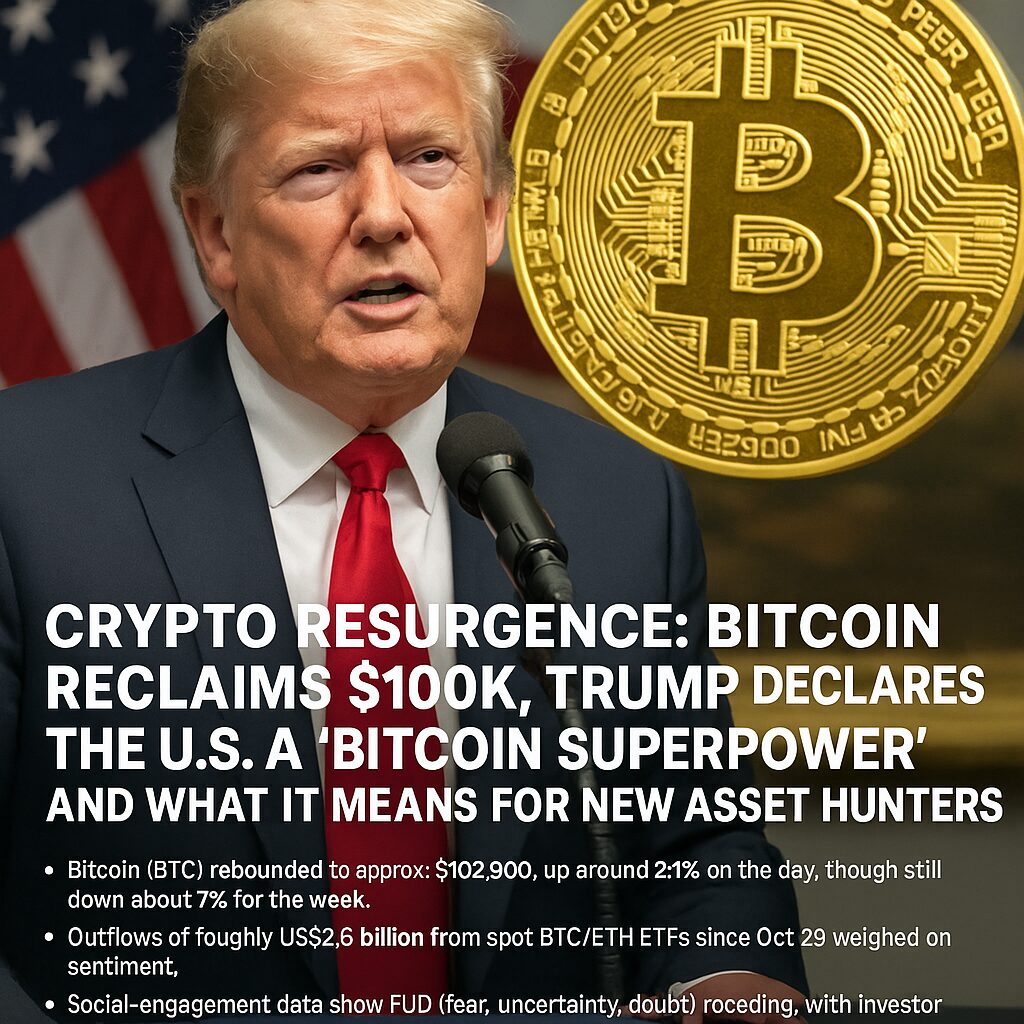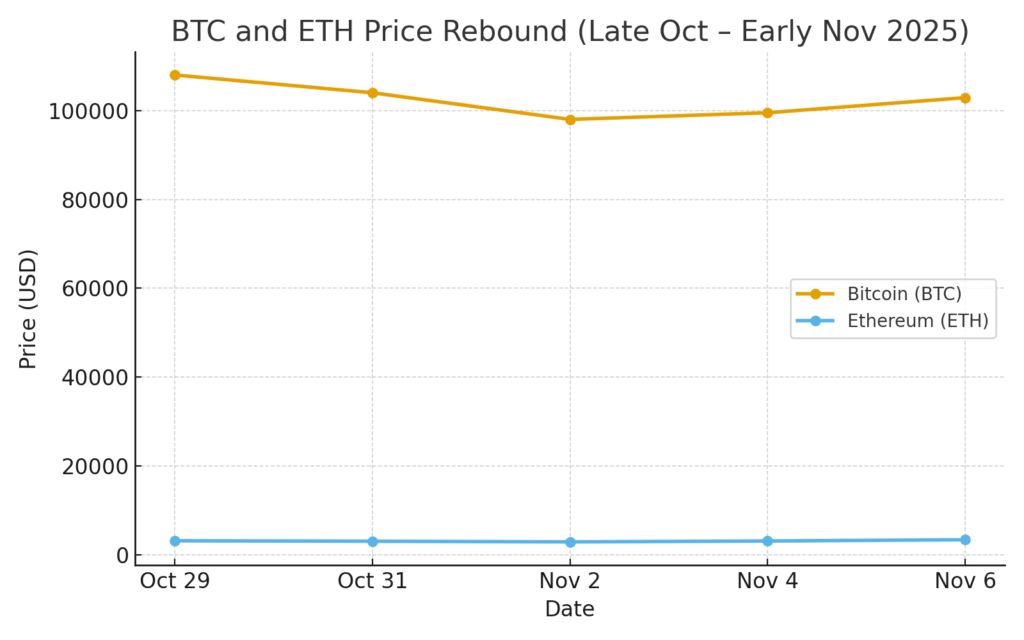
Main points :
- Bitcoin (BTC) rebounded to approx. $102,900, up around 2.1% on the day, though still down about 7% for the week.
- Outflows of roughly US$2.6 billion from spot BTC/ETH ETFs since Oct 29 weighed on sentiment.
- Social-engagement data show FUD (fear, uncertainty, doubt) receding, with investor activity rising.
- A macro catalyst: China paused its 24% tariff on U.S. goods for a year, improving risk appetite.
- Donald J. Trump declared the U.S. will become the “Bitcoin superpower” and global crypto capital—fueling bullish sentiment.
- Institutional flows remain intact: BTC ETF assets around US$145 billion, outflows only a small fraction (~2%).
- Headwinds remain: the U.S. government shutdown (35+ days) is delaying crypto regulation, raising tail risks.
1. Bitcoin’s Rebound and the Current Market Context

In the wake of recent volatility, the world’s largest cryptocurrency, Bitcoin (BTC), rallied to about US$102,900 (+2.1% on the day) after a period of sharp weakness that saw it fall below US$100,000. According to market observers, this move coincided with a broader risk-on shift as U.S. equity indices also recovered. The up-tick comes despite a roughly 7% drop in BTC’s value earlier in the week.
One of the main pressures on the market had been the large outflows from spot crypto ETFs: since October 29 the combined exodus from BTC and ETH products has totalled about US$2.6 billion, one of the largest redemption events on record. This reflects a risk-off posture triggered by macro uncertainty—among them trade friction, policy ambivalence and regulatory delays.
At the same time, data from on-chain analytics show hints of a mood change. Social-engagement metrics (which track sentiment and discussion volume) increased by more than 25%, signalling that fear and heavy selling may be waning. Rather than pure volume-driven panic, the market appears to be entering a phase of accumulation, albeit still within a volatile context.
For investors seeking new crypto assets or income-opportunities, the rebound suggests that while a clear breakout may not yet be confirmed, the low–to–mid US$100 k zone for BTC is serving as a psychological floor. A stable foundation here could create space for altcoins and blockchain-use cases to gather steam.
2. Altcoins Rising: Ethereum Takes Lead
While Bitcoin’s recovery is noteworthy, second-largest token Ethereum (ETH) has out-performed recently. ETH rallied up to US$3,430 (+7.6% at one point) as on‐chain activity strengthened and support zones held firm.
Underlying the rise are increased transactions on the Ethereum network and renewed developer / application engagement. For blockchain practitioners and developers (particularly in DeFi, NFTs, Layer‐2 scaling), this is a vital sign: that major chains are still commanding ecosystem activity even when market conditions are challenging.
For those scouting new assets beyond BTC/ETH, the implication is clear: chains with high-activity metrics, composable utility and governance-momentum stand a better chance of outperforming in a recovery phase. Investors might turn attention to projects built on Ethereum or interoperable networks that tap into real-world usage.
3. Macro Drivers: Trade, Sentiment and the U.S.–China Angle
A key driver behind the recent crypto uplift has been the loosening of trade tensions between the U.S. and China. On November 5, China announced a one-year suspension of its additional 24% tariffs on U.S. goods. That step bolstered risk-appetite in global markets—and crypto benefited as part of that broader uptick.
The dynamic here is two-fold: firstly, reduction in global trade friction improves investor risk-taking behaviour; secondly, it reduces pressure on the U.S. dollar and renders higher‐risk assets more attractive. Crypto, especially BTC which many view as a hedge or alternative asset, stands to gain in such an environment.
However, trade risks remain: should U.S.–China tensions flare again, or should macro policy tighten unexpectedly (e.g., via interest‐rate hikes or regulation), the crypto market remains susceptible to sharp reversals. For blockchain innovators and asset seekers, this means designing positioning with risk buffers: e.g., newer assets might benefit from diversification across chains and strategies.
4. Trump’s Crypto Pivot: U.S. Sets Sights on “Bitcoin Superpower” Status
One of the more dramatic influences on recent crypto sentiment has been the public pronouncement by Donald J. Trump. At the “America Business Forum” in Miami, Trump declared that the U.S. would become a “Bitcoin superpower” and the “crypto capital of the world”. He asserted that his executive orders had ended the federal “war on crypto”, emphasising that digital assets ease pressure on the U.S. dollar and boost American competitiveness—especially relative to China.
This shift is meaningful for several reasons:
- It signals a potentially friendlier regulatory posture (or at least a stated commitment).
- It adds a geopolitical dimension to crypto: assets are not just financial vehicles but also tools of national strategy.
- It raises the profile of on-chain innovation in payments, reserve asset classification, and institutional adoption.
For crypto asset hunters and blockchain practitioners, this implies that projects aligned with U.S. regulatory clarity—or that integrate into payment systems, stablecoin frameworks or institutional infrastructure—may benefit disproportionately. Consideration of U.S. jurisdictional alignment, compliance readiness and potential regulatory tailwinds should factor into asset selection.
5. Institutional Flows: Outflows Limited, Maturity Advancing
Although recent ETF outflows have grabbed headlines, commentary from industry watchers suggests that institutions remain committed. Financial advisor Rick Edelman noted that the US$2.6 billion outflow represented less than 2% of total assets under management in crypto products—thus not a structural flight but a tactical adjustment. Reflecting this, the total assets in BTC investment products remain at approximately US$145 billion, indicating maturity of crypto as an asset class.
For investors looking for alpha in new assets or trading strategies, the stability of institutional flows is a positive backdrop. It means that the narrative of crypto being “just retail speculation” is shifting: it is increasingly part of diversified portfolios. Assets that can prove institutional-grade infrastructure (custody, KYC/AML compliance, regulatory fit) will likely gain competitive advantage.
6. Regulatory & Governance Headwinds: Government Shutdown Looms
Despite the positive signals, notable headwinds remain. In the U.S., the government shutdown that has now exceeded 35 days has hampered progress on key crypto-regulation bills, raising the risk that legislation originally slated for late 2025 will drift into 2026. According to media reporting, roughly US$150 billion in economic cost may accrue from the shutdown.
For blockchain projects and assets in development, this raises three important considerations:
- Regulatory timing risk: If laws are delayed, regulatory clarity for new tokens or asset launches may be postponed.
- Policy uncertainty: Markets may react to headlines rather than fundamentals, increasing volatility risk.
- Jurisdictional arbitrage: Some developers or issuers may look beyond the U.S. to jurisdictions with clearer or faster frameworks.
Given this, projects that incorporate multi-jurisdictional strategies—e.g., dual listings, compliant tokens in both U.S. and offshore markets—may have an edge. For token presales or ICOs, structuring with jurisdictional flexibility will help reduce policy timing risk.
7. Implications for New Crypto Asset Seekers and Practical Blockchain Use
Bringing together the above threads, here are key take-aways for readers interested in discovering new crypto assets, generating income opportunities and tapping practical blockchain applications:
- Asset selection: In a rebounding market, assets with strong on-chain activity, institutional backing, and alignment with regulatory infrastructure may outperform. For example, chains with active DeFi ecosystems, payment integration or enterprise adoption will stand out.
- Timing and entry strategy: The window after a major price rebound and macro improvement (like now) can be fertile for accumulation. However, volatility remains elevated. Dollar-cost averaging and exposure limitation remain prudent strategies.
- Blockchain practicality: Real-world utility—such as settlement tokens, tokenised assets, cross-border payments and central-bank digital currency (CBDC) interoperability—will increasingly matter. Projects that deliver measurable usage will attract attention beyond pure speculation.
- Regulatory alignment: With the U.S. signalling a crypto-friendly posture (via Trump’s comments) yet also delivering delays in lawmaking, projects that front-run compliance (audits, transparency, KYC/AML readiness) will gain trust. This is especially true for token issuance platforms, wallets, remittance services and fintech-crypto integrators.
- Geopolitical and macro context: Crypto assets don’t exist in a vacuum. Trade policy, currency strength, and national strategic postures all influence flows. For example, if the U.S. proceeds with a “strategic bitcoin reserve” or incentivises tectonic integrations (payments, treasury), related assets or infrastructure layers may benefit.
Conclusion
The recent rebound of Bitcoin above US$100,000, combined with renewed risk-appetite, improving sentiment and high-profile political support (notably from Donald J. Trump), presents a compelling backdrop for anyone scanning for the next crypto asset or blockchain-based income opportunity. Still, the landscape is far from static: significant outflows, regulatory uncertainty and macro-risk persist. For those focused on new tokens, yield opportunities or blockchain integrations, the keys now lie in technical and on-chain fundamentals, regulatory positioning and utility beyond hype.
In practical terms: this may be a moment of opportunity—provided that project selection is rigorous, timing measured and regulatory alignment embedded. The narrative of “crypto as alternative finance” remains alive, and for those ready to act, this phase may herald the next wave of assets poised to benefit from the intersection of technology, policy and capital.

